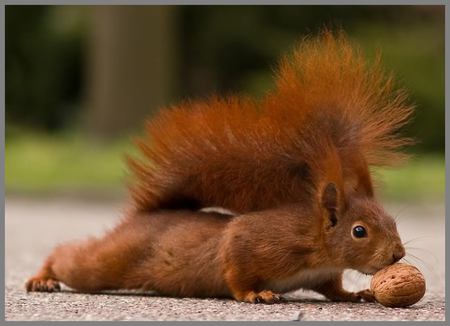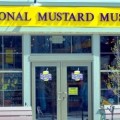So, You Know Your Nuts? . . . by Joseph G. Evrard, Staff Kentuckian

Well, they’re finally gone! It took three days of round-the-clock work, two front-end loaders and numerous dump truck loads to get rid of the stupid things! What, you might ask, did I get rid of? Nutshells. That’s right – nutshells. You see, around the holidays, my wife gets a bit nutty.
She comes home from the store with huge bags of walnuts, Brazil nuts, filberts, pecans, and almonds. She sets up her “nutting” area with the precision of a surgical nurse laying out instruments for a brain transplant – main nutcracker here, secondary nutcrackers there, nut picks over here, the bowl of nuts to be attacked and, of course, a big bowl for the empty shells.
Then it begins! From some time before Christmas until well after New Year’s, she cracks and eats nuts every spare moment. Then, as if someone throws a switch, some time in early January she eats the last nut; puts all the tools away and our house never sees another nut until Christmas rolls around again.
That’s when my job begins. As soon as she announces, “I’m done, dear,” my work begins. It’s my job to get rid of the mountain of nutshells left behind by her annual feed. At first I thought it would be a good idea to burn them in the wood stove. Wrong! The year I tried that I didn’t finish burning them until some time in July! Can you imagine what it does to your utility bill when you’re running your wood stove and your air conditioner at the same time?
The next year I tried using them in the garden as mulch. When the mulch pile got so high it blocked out the sun I gave up and hired somebody to haul the stuff off. This year, on the third straight day of shoveling nutshells out the window, it occurred that despite my intimacy with nuts, I really didn’t know much about them at all. This prompted me to do some research so that I can share with you some little known “nut facts.”
The nut we call the filbert was named in France. One day the renowned French general “Filbert the Conqueror” was resting with his army on the banks of the Seine River when an armada of flying saucers landed. Out popped thousands of little green men who began running around screaming, “We will conquer the Earth! We will conquer the Earth!” Sensing danger, Filbert ordered his men to repel the enemy.
His chief lieutenant asked how the men were to do that, as they were out of ammunition from their last battle and were on their way back to Paris for re-supply. Filbert thought for a moment then pointed to the thousands of nuts on the ground under some nearby trees. His men loaded their black powder rifles with the nuts and successfully fought off the invaders by pelting them with a hail of well-aimed nuts.
As the flying saucers lifted off and turned tail to run from Earth, a great cheer went up from the army as the men lifted Filbert to their shoulders to celebrate their great victory. Nobody knew what kind of nuts had saved the day, so on the spot they named the “filbert.” (Historical note: “Filbert the Conqueror’s” first name was Hazel. To this day some people use that name to refer to what we call the filbert).
Just as there is a spice named allspice, there is a tree named the “Allnut.” This is a hybrid, which grows filberts, almonds, macadamia nuts, pecans, chestnuts, and walnuts – all on the same tree. Each branch has a different kind of nut on it. The allnut tree is prized among gardeners with varied tastes but not enough land to grow a great variety of trees. Macadamia nuts have the highest IQ of any nut.
The coconut does not produce coconut milk. It comes from herds of dairy cows who graze beneath coconut trees. The cows eat the fallen coconuts and produce milk with the distinctive taste that has captured the fancy of many an epicure. Every once in a while, a cow will be killed by a falling coconut. This is a windfall to the farmer who quickly has the cow butchered to cash in on the fabulously high demand for coconut steaks, coconut roasts and burgers.
The original Nutcase was invented by Horace Q. Nutting of Nutley, New Jersey. Horace was an avid nut collector and was always looking for new and better ways to display his prized specimens. One day it occurred to him that he could profitably apply his hobby (woodworking) to the quest to find elegant ways to display his nuts. His first hand-fashioned nutcases were made from walnut, pecan and chestnut and were an immediate commercial success. The rest is history and accounts for the familiar advertising slogan – “If you value your nuts, you’ll keep them in a Nutting nutcase!”
Finally, I guess it had to happen. The universal popularity of nuts caused the demand to finally outstrip Mother Nature’s ability to produce pure wholesome natural nuts. Somebody, somewhere, is producing artificial nuts. I saw them myself the other day in, of all places, the hardware store. There, proudly displayed for all to see, were thousands of nuts, all sizes, all styles. They had square nuts, hex nuts, wing nuts, speed nuts, self-locking nuts, jam nuts, and nuts with “left-hand threads,” whatever those are! Go figure! Someone there had a loose nut.
I’ll bet those artificial nuts taste terrible! Who would buy such a thing? Only a real goober, I’ll bet.
See ya around,
BUCK





